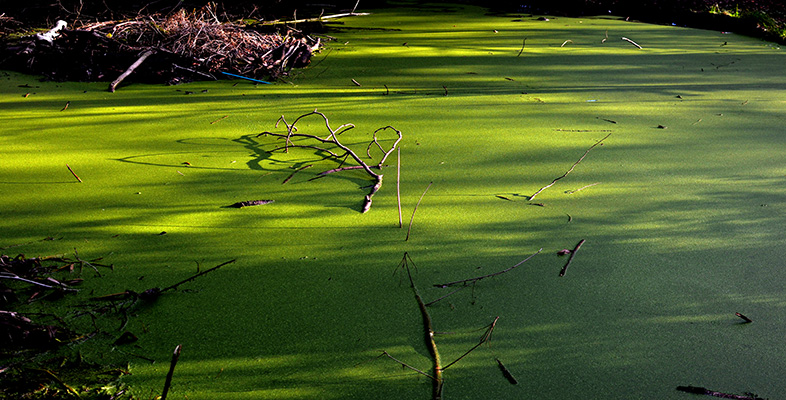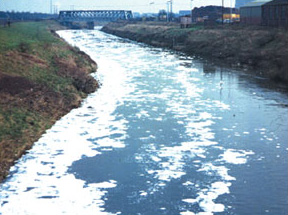1.4 Human-induced eutrophication
While eutrophication does occur independently of human activity, increasingly it is caused, or amplified, by human inputs. Human activities are causing pollution of water bodies and soils to occur to an unprecedented degree, resulting in an array of symptomatic changes in water quality and in species and communities of associated organisms. In 1848 W. Gardiner produced a flora of Forfarshire, in which he described the plants growing in Balgavies Loch. He talked of ‘potamogetons [pondweeds] flourishing at a great depth amid the transparent waters, animated by numerous members of the insect and finny races’. These ‘present a delightful spectacle, and the long stems of the white and yellow water lilies may be traced from their floating flowers to the root’. By 1980, the same loch had very low transparency and dense growths of planktonic algae throughout the summer. The submerged plants grew no deeper than 2 m, and in the 1970s included just three species of Potamogeton, where previously there were 17.
For any ecosystem, whether aquatic or terrestrial, nutrient status plays a major part in determining the range of organisms likely to occur. Characteristic assemblages of plant and associated animal species are found in water with different trophic states. Table 1.3 shows some of the aquatic macrophyte species associated with different concentrations of phosphorus in Britain.
| Phosphorus present as soluble reactive phosphorus (SRP) Footnotes */mg P l-1 | Plant species (see Figure 1.8 for illustrations) |
|---|---|
| bog pondweed, Potamogeton polygonifolius river water-crowfoot,Ranunculus fluitans | |
| 0.1-0.4 | fennel-leaved pondweed, Potamogeton pectinatus |
| 0.4-1.0 | yellow water-lily,Nuphar lutea arrowhead,Sagittarias agittifolia |
| >1.0 | spiked water-milfoil, Myriophyllum spicatum |
Footnotes
* This term is explained in Section 2.1. Back to main textSAQ 6
What impression would you gain from an observation that a population of river water-crowfoot in a particular stretch of river had been largely replaced by fennel-leaved pondweed over a three-year period?
Answer
The phosphorus concentration of the water may have increased.
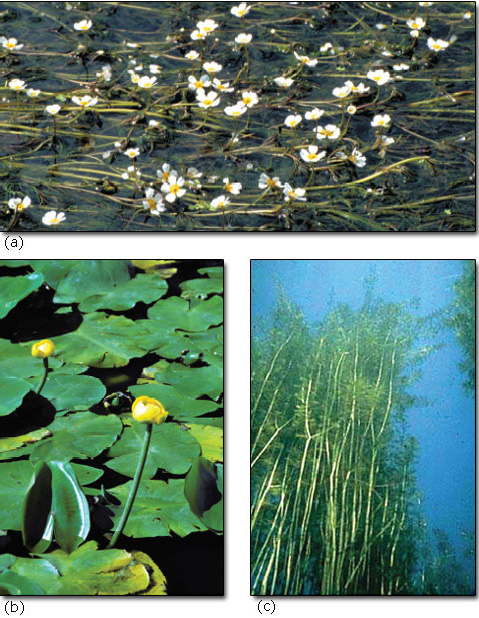
Figure 1.9 illustrates the relationship between levels of total phosphorus in standing water and the nutrient status of lakes. Above a level of 0.1 mg phosphorus per litre, biodiversity often declines. Using the trophic bands defined in Table 1.2, this is the concentration at which lakes are considered to become hypertrophic. This is way below the standard of 50 mg l−1 set as the acceptable limit for phosphorus in drinking water. Nutrient loadings this high are generally caused by human activities. Extremely high levels of eutrophication are often associated with other forms of pollution, such as the release of toxic heavy metals, resulting in ecosystems that may no longer support life (Figure 1.10).

For lakes with no written historical records, the diatom record of sediments can be used to study earlier periods of natural change in water quality, and to provide a baseline against which to evaluate trends in artificial or human-induced eutrophication. Diatoms are microscopic photosynthetic organisms (algae of the kingdom Protoctista), which live either free-floating in lakes or attached to the surface of rocks and aquatic vegetation. It is well established that some species of diatom can tolerate oligotrophic conditions whereas others flourish only in more eutrophic waters. When they die, their tiny (
Studies of diatom remains have demonstrated that current levels of eutrophication far exceed those found historically. In the English Lake District, productivity and sediment input increased in some lakes when vegetation was cleared by Neolithic humans around 5000 years ago, and again when widespread deforestation occurred 2000 years ago. However the greatest increases in productivity, sediment levels and levels of carbon, nitrogen and phosphorus, have occurred since 1930. Figure 1.11 shows the general pattern of changes in productivity in Cumbrian lakes through history as the type and intensity of human activities has changed.
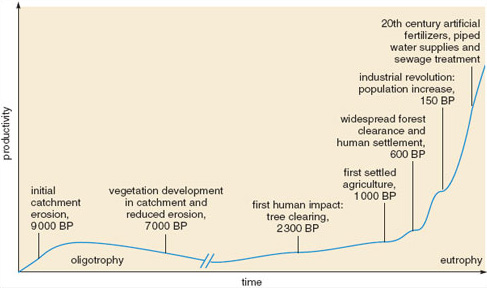
In the Norfolk Broads, the waters of the River Ant had a diverse macrophyte flora during the 19th century. The submerged species known as water soldier (Stratiotes aloides, Figure 1.12) was common, but by 1968 the only macrophytes remaining were those with permanently floating leaves, such as water-lilies. During that period, throughout the Broads, there was a general trend away from clear-water habitats, typified by, for example, the diminutive angiosperm known as the holly-leaved naiad (Najas marina), towards habitats containing more productive species, such as pondweeds (Potamogeton spp.) andhornworts (Ceratophyllum spp.). In some cases, they eventually became eutrophic habitats with turbid water, typified by free-floating green algae and cyanobacteria, with very few macrophytes at all. For example, hornwort (Ceratophyllum demersum) was almost choking Alderfen Broad in 1963, but had almost disappeared by 1968 to be replaced eventually by algal blooms in the 1990s.
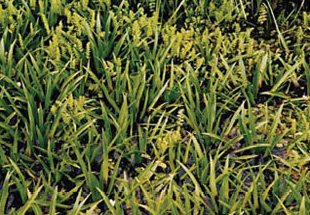
Sediment cores from the River Ant and neighbouring broads suggest that observed changes in plant community composition were linked to rising levels of total phosphorus: mean levels in the area rose dramatically between 1900 and 1975 (Figure 1.13), but have since fallen as a result of actions taken to remove phosphorus from the system.
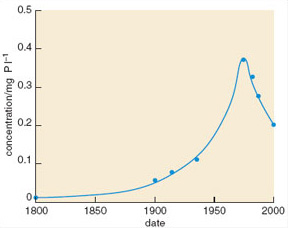
SAQ 7
Using the trophic bands in Table 1.2, describe the change in the River Ant broads between 1800 and 1975.
Answer
In 1800 the water was at the upper end of the oligotrophic range; it had moved through the mesotrophic range to become eutrophic by 1900, and by 1940 would be classed as hypertrophic. Between 1940 and 1975 there was a further threefold increase in the concentration of total phosphorus.
Eutrophication has damaged a large number of sites of special scientific interest (SSSIs) designated in the UK under the Wildlife and Countryside Act of 1981: English Nature has identified a total of 90 lake SSSIs and 12 river SSSIs that have been adversely affected. Artificial eutrophication in rivers is even more widespread than in lakes and reservoirs. Human activities worldwide have caused the nitrogen and phosphorus content of many rivers to double and, in some countries, local increases of up to 50 times have been recorded.
Eutrophication has also become a problem for terrestrial wildlife. Deposition of atmospheric nitrogen and the use of nitrogen-rich and phosphorus-rich fertilizers in agriculture has resulted in nutrient enrichment of soils and has caused associated alteration of terrestrial plant and animal communities.
Some of the effects of large-scale eutrophication have adverse consequences for people, and efforts to manage or reduce eutrophication in different countries now cost substantial sums of money. Removing nitrates from water supplies in England and Wales cost £20 million in 1995. Higher frequency of algal blooms increases the costs of filtration for domestic water supply and may cause detectable tastes and odours due to the secretion of organic compounds. If the bloom is large, these compounds can accumulate to concentrations that are toxic to mammals and sometimes fish. Furthermore, the high productivity of the blooms means that although oxygen is released by photosynthesis during the day, the effect of billions of cells respiring overnight can deplete the water of oxygen, resulting in fish dying through suffocation even if they tolerate the toxins.
SAQ 8
Are fish most at risk from suffocation in warm or cool water?
Answer
Warm water, because oxygen is less soluble at warmer temperatures and is therefore more rapidly depleted by respiring organisms, especially as respiration rate also increases with temperature.
Another problem caused to the water industry by algal blooms is the production of large quantities of fine organic detritus, which, when collected within waterworks’ filters, may support clogging communities of aquatic organisms such as nematode worms, sponges and various insects. These may subsequently find their way into water distribution pipes and on occasion appear in tap water!
